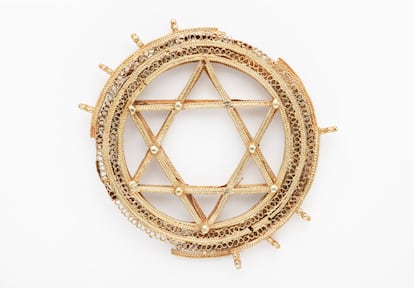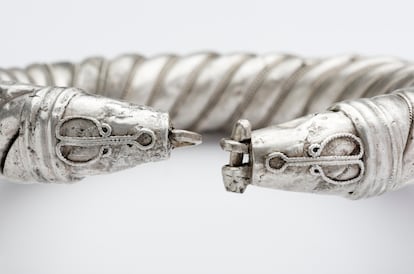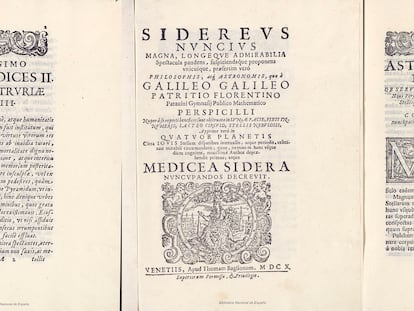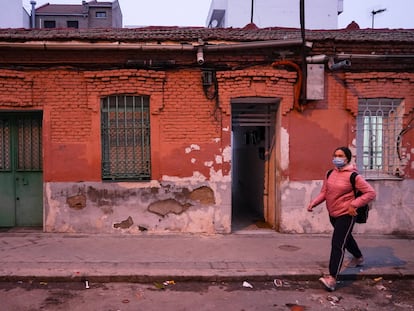How an 11th-century buried treasure ended up for sale on social media
Police in Córdoba seized the priceless jewelry collection after being alerted to its existence by a local archaeologist who spotted photos of the pieces online


In 1009, a civil war broke out in the Caliphate of Córdoba – a territory comprising Al-Andalus, the Muslim-ruled area of the Iberian peninsula, and parts of North Africa – and lasted more than 20 years. The conflict between the two warring factions seeking power in the south of the peninsula led to the deposition of the caliph Hisham II and the division of Al-Andalus into numerous taifas – independent Muslim principalities. Political instability spread and fear prevailed among the public, which, according to experts, could explain why a rich Jewish citizen buried a spectacular collection of treasure in what is today the municipality of Baena, Córdoba in Spain’s southern Andalusia region.
A thousand years later, a photograph that appeared on social media alerted the National Police in the region to the treasure’s existence and the fact that it could be illegally traded. The ensuing investigation resulted in the seizure last year of the “11th century’s best collection of jewelry,” according to Alberto Canto, professor of archaeology at the Autonomous University of Madrid. The incredible find is now on display at the Archaeological Museum of Córdoba.
It is simply spectacular. I have not seen anything like itAlberto Canto, professor of archaeology at the Autonomous University of Madrid
The so-called Amarguilla treasure, which got its name from the estate where it was found, comprises a set of 623 pieces of 11th-century jewelry, including 98 pieces of gold, silver and gilded silver. Among the gold pieces are four wrist and ankle bracelets, whose joiners are shaped to look like a bird’s heads, as well as a delicate Star of David set within a gold ring. Also of note are 14 quartz and rock crystal gems, four pink coral beads, 31 glass paste stones in different colors and 476 irregular pearls and pearl beads. “The condition of the collection is good, particularly as it has spent the past year undergoing a process of restoration by experts from the Museum of Córdoba,” according to the Andalusian regional government, which spent €15,000 on restoring the collection.
“It is simply spectacular,” says Canto, one of the world’s leading specialists in Al-Andalus and a researcher of the Medina Azahara archeological site. “I have not seen anything like it. It is impossible to know who hid it or to whom it belonged, because it lacks coins, but most likely it belonged to a Jewish individual, since there is a Star of David among the pieces. It also looks like a bride’s trousseau, because it includes many pieces that would be attached to tunics.”

But Canto believes the collection is not complete, as the coin element has not been found. “All Umayyad Caliphate treasures include coins, which suggests that, in this case, they have been sold because these kinds of pieces sell easily, while the jewelry does not. No antique dealer or collector would buy them [the jewelry pieces]. The lack of coins makes it difficult for us to establish exactly when it was buried. But I am leaning towards the beginning of the 11th century.”
According to the experts consulted, the treasure was buried inside a bag or a ceramic container in the ground. Indeed, all of the pieces were stained by soil, indicating the treasure had been dug up only recently. The police investigation took place in the Córdoba municipalities of Lucena, Luque and Baena, where the treasure was finally found in an industrial warehouse. The person who had it in their possession took the police to an estate in Baena where they claimed to have found it.

However, the individual’s explanations regarding the original site of the buried treasure reportedly failed to convince archaeologists and consequently, no excavation has been undertaken to determine whether other elements are still to be discovered there.
National Police sources explain that their attention was first drawn to the treasure up for sale online by a local archaeologist who discovered photographs of several pieces with possible archaeological value on social media. The police were then able to follow a trail that eventually led them to the treasure. Once discovered, the individual who had the treasure in their possession intended to deliver it to the Baena City Council, though in the end it was handed to the Andalusian regional government and from there to the museum. The police stress that their investigation was only intended to avoid the possibility of the treasure being traded illegally.
Meanwhile, the director of the Archaeological Museum of Córdoba, María Dolores Baena, is keen to flag up the restoration work that has been carried out on the collection, which includes the most advanced techniques, such as laser technology, to restore the treasure’s original appearance. Until June 6, the collection will be displayed as a temporary exhibition at the museum, which boasts more than 35,000 pieces. The jewels will then go on to form part of the museum’s permanent exhibition. “It is one of the best collections of jewelry we own,” says Baena. “The six-pointed star is unique. There is nothing like it, making it extraordinary valuable.”
English version by Heather Galloway.
Tu suscripción se está usando en otro dispositivo
¿Quieres añadir otro usuario a tu suscripción?
Si continúas leyendo en este dispositivo, no se podrá leer en el otro.
FlechaTu suscripción se está usando en otro dispositivo y solo puedes acceder a EL PAÍS desde un dispositivo a la vez.
Si quieres compartir tu cuenta, cambia tu suscripción a la modalidad Premium, así podrás añadir otro usuario. Cada uno accederá con su propia cuenta de email, lo que os permitirá personalizar vuestra experiencia en EL PAÍS.
¿Tienes una suscripción de empresa? Accede aquí para contratar más cuentas.
En el caso de no saber quién está usando tu cuenta, te recomendamos cambiar tu contraseña aquí.
Si decides continuar compartiendo tu cuenta, este mensaje se mostrará en tu dispositivo y en el de la otra persona que está usando tu cuenta de forma indefinida, afectando a tu experiencia de lectura. Puedes consultar aquí los términos y condiciones de la suscripción digital.
More information
Últimas noticias
David Bowie, the galactic thinker who encouraged us to break new ground
John Berger and the loss of rural culture
From police officer to bloodthirsty kidnapper: Terror in Mexico during the years of ‘The Ear Chopper’
Alain Aspect, Nobel laureate in physics: ‘Einstein was so smart that he would have had to recognize quantum entanglement’
Most viewed
- David King, chemist: ‘There are scientists studying how to cool the planet; nobody should stop these experiments from happening’
- Reinhard Genzel, Nobel laureate in physics: ‘One-minute videos will never give you the truth’
- Oona Chaplin: ‘I told James Cameron that I was living in a treehouse and starting a permaculture project with a friend’
- Sinaloa Cartel war is taking its toll on Los Chapitos
- Mexico completes its trade shift with the entry into force of tariffs on China and countries without trade agreements










































